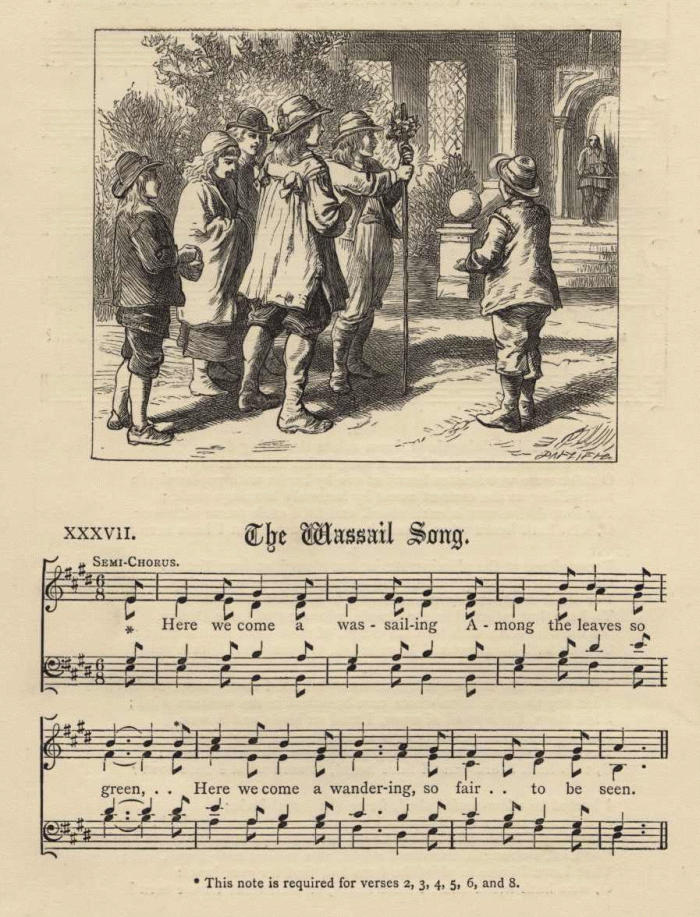 |
| "The King Drinks" by David Teniers the Younger depicts Twelfth Night revelers |
Twelfth Night was one of the most celebrated Christian holidays in the 18th century. It marked the end of the Twelve Days of Christmas and the coming of Epiphany. Most calendars put Twelfth Night on January 6 (the night of Epiphany) but others put it on January 5, the end of the twelve day period beginning on Christmas Day.
In medieval and Tudor England Twelfth Night marked the end of a winter festival that started on All Hallows Eve (Halloween). The Lord of Misrule presided and symbolized the world turning upside down. On this day the King and all those who were high would become the peasants and all those who were peasants would rise in status. At the beginning of the Twelfth Night festival, a cake that contained a bean was eaten. The person who found the bean would rule the feast. Midnight signaled the end of his rule and the world would return to normal. This Lord of Misrule tradition dates back to pre-Christian European festivals such as the Celtic festival of Samhain and the Ancient Roman festival of Saturnalia.
Food and drink are the center of modern celebrations, and the most traditional recipes go back many centuries. Particularly in England, the punch called Wassail is consumed throughout the Christmas season, but especially on Twelfth Night.

Around the world, special pastries, such as the Tortell and King Cake are baked on Twelfth Night, and eaten the following day for the Feast of the Epiphany celebrations. In English and French custom, the Twelfth Night Cake was baked to contain a bean and a pea, and those who received the slices containing them would be designated King and Queen of the night's festivities - sometimes they were also made responsible for the expenses of the evening as well.
In colonial America, a Christmas wreath was always left up on the front door of each home, and when taken down at the end of the Twelve Days of Christmas, any edible portions would be consumed with the other foods of the feast. The same held true in the 19th- and 20th-centuries with fruits adorning Christmas trees. Fresh fruits were hard to come by, and were therefore considered fine and proper gifts and decorations for the tree, wreaths, and home. In more modern times, some consider it unlucky to leave Christmas decorations up after Twelfth Night as a result of this tradition.
Since Twelfth Night was a day most families were gathered anyway, it was a popular day for weddings. Because of this, Twelfth Night Cake can also be found in many period cookbooks under the name of Bride's Cake. (Information from wikipedia and Jas. Townsend)
Wassail Recipe
From Colonial Williamsburg. The name comes from the traditional toast "Wass Hael" which meant "be whole" or "be well."
Ingredients
1 cup sugar
4 cinnamon sticks
3 lemon slices
2 cups pineapple juice
2 cups orange juice
6 cups dry red wine
½ cup lemon juice
1 cup dry sherry
2 lemons, sliced
Directions:
Boil the sugar, cinnamon sticks, and 3 lemon slices in ½ cup of water for 5 minutes and strain. Discard the cinnamon sticks and lemon slices.
Heat but do not boil the remaining ingredients. Combine with the syrup, garnish with the lemon slices, and serve hot.
Twelfth-Night Cake Recipe
From The London Art of Cookery, by John Farley, 1800 (reproduced and updated by Jas. Townsend (www.jas-townsed.com). We've removed the directions for cooking in a wood fired oven and mixing by hand from the original recipe and used only Townsend's instructions for modern cooking.
Ingredients
8 oz. unsalted butter
1 1/2 c. powdered sugar
1/2 tsp. each, salt, ground nutmeg, cinnamon, ginger
1/4 tsp. each, ground allspice, mace, coriander
4 eggs
1 egg yolk
1/4 c. brandy
1 1/2 c. pastry flour
1 c. raisins or currants
1 c. slivered almonds
1/2 c. candied orange rind
1/2 c. candied lemon rind
butter for baking pan
Meringue
3 egg whites
1/2 tsp. lemon juice
3/4 c. powdered sugar
Directions
Preheat your oven to 275-degrees (F)
Cream together the butter and sugar, then stir in the salt, spices and brandy. Beat in eggs, one at a time, then beat 7 minutes with an electric mixer. The batter will be light an airy, sift in flour a little at a time, folding it in until just incorporated. Gently fold in raisins, almonds, and candied rinds. Line the bottom of your baking dish with paper, and coat both the paper and the pan with butter, or if using a cake mold, liberally butter the inside surface. Fill the pan to the brim with your batter (don't forget to hide the bean or a small toy in the cake), then smooth over the top of the batter. Makes about 6 cups of batter.
Bake for 3 hours. The cake should be golden brown and a toothpick inserted should come out clean.
Allow the cake to cool slightly, then run a knife around the inside of the pan and invert onto a serving dish.
When the cake is completely cooled, whip the egg whites, and lemon juice until stiff peaks form. Gently sift and fold in the powdered sugar, a little at a time. Spread the meringue on the cake, then place back in a 250-degree (F) oven for 15 minutes, until the meringue sets.

No comments:
Post a Comment